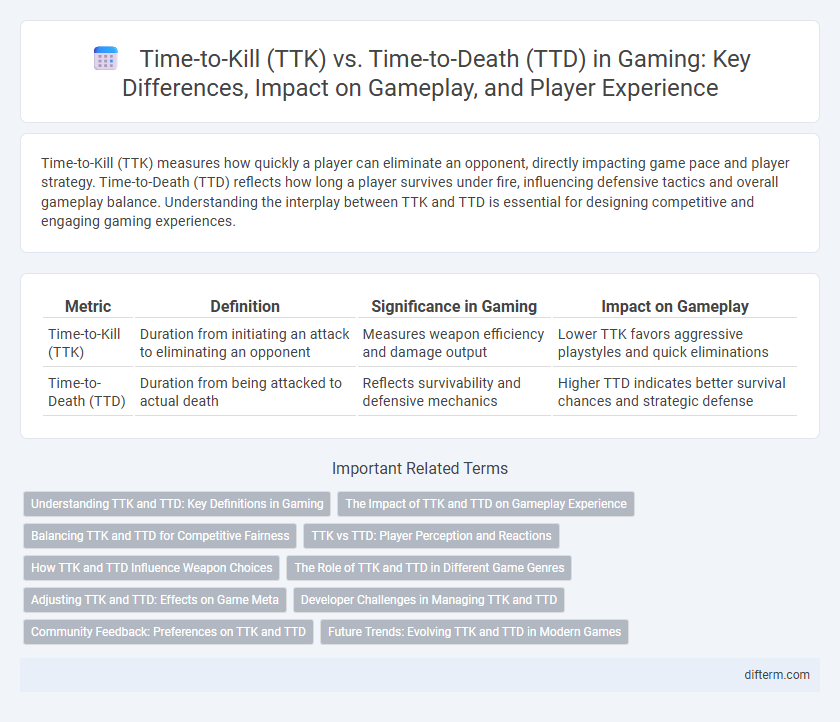Time-to-Kill (TTK) measures how quickly a player can eliminate an opponent, directly impacting game pace and player strategy. Time-to-Death (TTD) reflects how long a player survives under fire, influencing defensive tactics and overall gameplay balance. Understanding the interplay between TTK and TTD is essential for designing competitive and engaging gaming experiences.
Table of Comparison
| Metric | Definition | Significance in Gaming | Impact on Gameplay |
|---|---|---|---|
| Time-to-Kill (TTK) | Duration from initiating an attack to eliminating an opponent | Measures weapon efficiency and damage output | Lower TTK favors aggressive playstyles and quick eliminations |
| Time-to-Death (TTD) | Duration from being attacked to actual death | Reflects survivability and defensive mechanics | Higher TTD indicates better survival chances and strategic defense |
Understanding TTK and TTD: Key Definitions in Gaming
Time-to-Kill (TTK) measures the duration required for a player to eliminate an opponent, directly impacting weapon effectiveness and player strategy. Time-to-Death (TTD) reflects the interval a player survives after being attacked, influencing defensive tactics and game balance. Understanding TTK and TTD helps players optimize gameplay decisions and developers fine-tune competitive mechanics for immersive gaming experiences.
The Impact of TTK and TTD on Gameplay Experience
Time-to-Kill (TTK) and Time-to-Death (TTD) critically shape player engagement by influencing the pacing and intensity of combat encounters in games. Short TTK values create fast-paced, high-adrenaline gameplay that emphasizes reflexes and quick decision-making, while longer TTKs favor tactical depth and strategic planning. Balancing TTK and TTD directly affects player satisfaction, competitiveness, and the overall flow of multiplayer matches, making it essential for developers to tailor these metrics to their game's core experience.
Balancing TTK and TTD for Competitive Fairness
Balancing Time-to-Kill (TTK) and Time-to-Death (TTD) is crucial for maintaining competitive fairness in gaming, as it directly influences player skill expression and reaction time. Short TTK values favor aggressive playstyles but can reduce strategic depth, while longer TTK allows for more tactical decision-making and comeback opportunities. Optimizing TTK and TTD metrics ensures a balanced gameplay experience that rewards both precision and strategy, fostering an engaging and fair competitive environment.
TTK vs TTD: Player Perception and Reactions
Time-to-Kill (TTK) and Time-to-Death (TTD) critically influence player perception and reactions in gaming, as shorter TTKs often create a sense of urgency and increase adrenaline, while longer TTDs allow for strategic decision-making and reactive gameplay. Players typically perceive shorter TTKs as more skill-dependent, demanding faster reflexes, whereas longer TTDs may be seen as accommodating tactical retreats or team support. Understanding the balance between TTK and TTD is essential for developers to shape engaging combat dynamics that align with diverse player preferences and reaction times.
How TTK and TTD Influence Weapon Choices
Time-to-Kill (TTK) and Time-to-Death (TTD) critically influence weapon choices by determining the efficiency and survival dynamics in gameplay. Weapons with low TTK are favored for aggressive plays, ensuring quick eliminations, while those impacting TTD affect defensive strategies by prolonging survivability under fire. Understanding the balance between TTK and TTD helps players select weapons optimized for either rapid offense or sustained defense, enhancing overall tactical effectiveness.
The Role of TTK and TTD in Different Game Genres
Time-to-Kill (TTK) and Time-to-Death (TTD) metrics critically influence player experience and strategy across gaming genres. In first-person shooters, low TTK values emphasize quick reflexes and precision, while higher TTK in RPGs encourages tactical decision-making and character development. Real-time strategy games balance TTK and TTD to maintain pacing and challenge, fostering strategic planning over individual combat speed.
Adjusting TTK and TTD: Effects on Game Meta
Adjusting Time-to-Kill (TTK) and Time-to-Death (TTD) directly influences gameplay pacing and player strategies in competitive shooters. Lowering TTK results in faster eliminations, favoring aggressive playstyles and high-precision weapons, while increasing TTD can create more survival opportunities and emphasize tactical retreats. These tweaks shift the game meta by balancing offensive power and defensive resilience, impacting weapon viability and player engagement.
Developer Challenges in Managing TTK and TTD
Balancing Time-to-Kill (TTK) and Time-to-Death (TTD) presents significant challenges for developers aiming to create fair and engaging gameplay. Short TTK can lead to frustration and reduce strategic depth, while extended TTD risks slowing game pace and diminishing player excitement. Developers must fine-tune weapon damage, player health, and latency compensation to optimize TTK and TTD, ensuring competitive integrity and maintaining player retention.
Community Feedback: Preferences on TTK and TTD
Community feedback on Time-to-Kill (TTK) versus Time-to-Death (TTD) in gaming reveals a strong preference for balanced TTK that enhances skill expression while minimizing frustration. Players often favor shorter TTK for fast-paced gameplay and quick reward cycles, but some advocate longer TTK to encourage strategic play and reduce randomness. Feedback consistently highlights the need for developers to consider player skill levels, game genre, and competitive integrity when adjusting TTK and TTD parameters.
Future Trends: Evolving TTK and TTD in Modern Games
Future trends in gaming reveal shrinking Time-to-Kill (TTK) values to enhance fast-paced combat and increase player engagement. Advanced AI and adaptive difficulty systems dynamically adjust Time-to-Death (TTD) to balance challenge and accessibility across diverse player skill levels. Emerging technologies like cloud gaming and ray tracing further influence TTK and TTD by enabling smoother graphics and faster response times, shaping immersive gameplay experiences.
Time-to-Kill (TTK) vs Time-to-Death (TTD) Infographic

 difterm.com
difterm.com